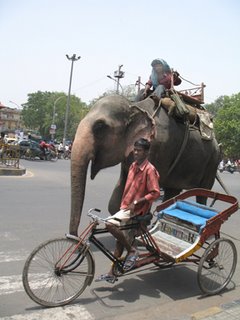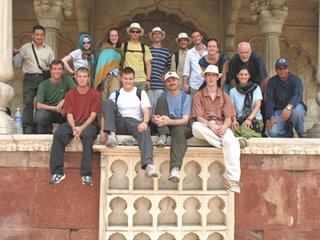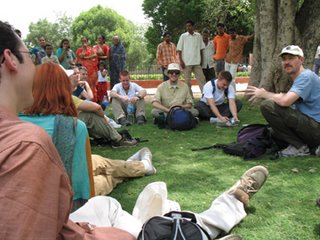Thursday, May 18, 2006
Purity and pollution

In an effort to prepare us for the glorious chaos of India, Derek discussed during our first few organizational meetings how purity and pollution manifests in Indian life and culture. We see pollution in many neighborhoods, scraps of trash and waste, cows and dogs and chickens roaming the dusty streets, the haze that hovers over Delhi in the morning. We also see evidence of purity, perfection in the structured spaces of the Red Fort and the design of that Jantar Mantar sundial. There are streetside shop vendors who, in spite of the dusty chaos around them, offer perfectly stacked hands of bananas and melons and cloth. Others walk through traffic with a platter of diamond-shaped slices of coconut arranged in the shape of a curved wreath perched on one hand. In our group, we seek out filtered water, tablets, and bottled mineral water. We drink, at minimum, three litres a day to avoid dehydration and general fatigue. Yet sometimes the elements, no matter how much water one drinks, no matter how much protection we seek from sunblock and repellant, will trump us and our sensibilities. It was a hot day, and many of us toted two litre bottles of water. We made our way, via tourist bus, to the Red Fort, built by Shah Jahan from 1628 to 1638, just after the completion of the Taj Mahal when the Mughal em
 peror decided to move the capital north from Agra to Delhi. Beyond the brick red stone walls of the fort are clusters of marble buildings offering detailed inlay. 32 gardens and many open spaces. Given the hot day and the buildings’ marbled floors, it was easy to see how the Mughals managed to keep cool in weather like this. In its heyday, canals of scented water channeled through the fort. Before we toured the Red Fort, we found a cool space under a tree and Derek offered a brief lecture about the history of the Red Fort. A few men and some families, drawn by the small crowd that our group (by definition) makes, sat and stood among us as
peror decided to move the capital north from Agra to Delhi. Beyond the brick red stone walls of the fort are clusters of marble buildings offering detailed inlay. 32 gardens and many open spaces. Given the hot day and the buildings’ marbled floors, it was easy to see how the Mughals managed to keep cool in weather like this. In its heyday, canals of scented water channeled through the fort. Before we toured the Red Fort, we found a cool space under a tree and Derek offered a brief lecture about the history of the Red Fort. A few men and some families, drawn by the small crowd that our group (by definition) makes, sat and stood among us as  Derek continued his lecture about Shah Jahan and the creation of the Red Fort. He told us that the idea of creating a place like the Red Fort embodied Muslims ideas of what heaven or paradise might be like. “These beautiful gardens and flowing waters offered a beautiful vocabulary of describing life after death for many people,” Derek said. “Many of them lived in the desert, and so the words they used to describe heaven are water and lush gardens.” While we were nearly the only western tourists visiting the Red Fort that day (we saw perhaps two or three other westerners), there was no shortage of Indian tourists and school groups of children. Everyone was there on holiday and our time there had this sense of playful leisure that hasn’t quite yet manifested among people we’ve met in the street. Many of us were approached by children and young men, wanting to have their picture taken. There were many giggles and exchanges of: “Where are you from?” We readily complied. From the Red Fort, we walked on the sidewalk amid what felt like a small circus, to the Jama Masjid (an Islamic mosque). There were vendors who sold fake beards and fans and postcards. One man napped, with a scale before him, as he waited for someone who would pay him a few rupees to be weighed. Another sold fresh slices of peeled cucumber, which looked tempting and refreshing in spite of the dusty street and lack of refrigeration. We saw a pair of elephants on the street, and one of them sprayed their nose-jazz on JT. We dodged through traffic to m
Derek continued his lecture about Shah Jahan and the creation of the Red Fort. He told us that the idea of creating a place like the Red Fort embodied Muslims ideas of what heaven or paradise might be like. “These beautiful gardens and flowing waters offered a beautiful vocabulary of describing life after death for many people,” Derek said. “Many of them lived in the desert, and so the words they used to describe heaven are water and lush gardens.” While we were nearly the only western tourists visiting the Red Fort that day (we saw perhaps two or three other westerners), there was no shortage of Indian tourists and school groups of children. Everyone was there on holiday and our time there had this sense of playful leisure that hasn’t quite yet manifested among people we’ve met in the street. Many of us were approached by children and young men, wanting to have their picture taken. There were many giggles and exchanges of: “Where are you from?” We readily complied. From the Red Fort, we walked on the sidewalk amid what felt like a small circus, to the Jama Masjid (an Islamic mosque). There were vendors who sold fake beards and fans and postcards. One man napped, with a scale before him, as he waited for someone who would pay him a few rupees to be weighed. Another sold fresh slices of peeled cucumber, which looked tempting and refreshing in spite of the dusty street and lack of refrigeration. We saw a pair of elephants on the street, and one of them sprayed their nose-jazz on JT. We dodged through traffic to m ake it to the mosque, walked through a marketplace and climbed the steps to India’s largest mosque. The afternoon prayers were about to begin, however, and the guards did not want to let us in, even for a moment, to view its interior. Our shoes were already off. Lynda, Danielle and Ashley had bought head scarves. I had mine on, too. Nabeel, who is Muslim, was allowed to enter. We all waited outside as the conversation continued somewhere else about whether we would be allowed in. We were not. People moved in and out of the great metal doors of the mosque. And just above us, three loudspeakers carried a sonic version of the activities within the great building. A man sang the call for prayers. It enveloped every molecule around us. Stunning. Nabeel emerged from the mosque and we walked to the bus, which was parked on the other side of the building. To get to the other side, we walked down the hundreds of steps through a beggar’s alley (so it seemed) for there was no shortage of women and children who sought out photos from us, who wanted rupees, etc. In spite of being shut out of the mosque, many of us felt buoyed after having heard the call to prayer. The reality of the poverty in India emerged too soon for some of us. We found the bus and had lunch at the YMCA in Delhi. The YMCA here houses travelers, offers aryuvedic services, and has a fine restaurant. In spite of the sustenance, somewhere between the heat of the afternoon, the mosque-to-beggar’s alley dynamic, and the last few resonances of jet lag, exhaustion had set in for many of us. Rather than going outside to see the ghat where Ghandi was cremated, we visited the mostly air conditioned National Museum. There was an exhibit of Buddhist sculptures and thangka paintings, and the lone remnant of the historic Buddha’s bone. It was enshrined in a tiered wedding-cake shaped pillar of gold and sealed in a protective see-through case. We made it back to Pahar Ganj, where naps never felt so good, where rice pullao was a phone call away, and where the Internet provided slow but steady access to the world outside. We leave Saturday (super-early) for Agra… not sure how reliable the Internet will be in the next couple weeks, but I’ll send dispatches when I can! -Erica
ake it to the mosque, walked through a marketplace and climbed the steps to India’s largest mosque. The afternoon prayers were about to begin, however, and the guards did not want to let us in, even for a moment, to view its interior. Our shoes were already off. Lynda, Danielle and Ashley had bought head scarves. I had mine on, too. Nabeel, who is Muslim, was allowed to enter. We all waited outside as the conversation continued somewhere else about whether we would be allowed in. We were not. People moved in and out of the great metal doors of the mosque. And just above us, three loudspeakers carried a sonic version of the activities within the great building. A man sang the call for prayers. It enveloped every molecule around us. Stunning. Nabeel emerged from the mosque and we walked to the bus, which was parked on the other side of the building. To get to the other side, we walked down the hundreds of steps through a beggar’s alley (so it seemed) for there was no shortage of women and children who sought out photos from us, who wanted rupees, etc. In spite of being shut out of the mosque, many of us felt buoyed after having heard the call to prayer. The reality of the poverty in India emerged too soon for some of us. We found the bus and had lunch at the YMCA in Delhi. The YMCA here houses travelers, offers aryuvedic services, and has a fine restaurant. In spite of the sustenance, somewhere between the heat of the afternoon, the mosque-to-beggar’s alley dynamic, and the last few resonances of jet lag, exhaustion had set in for many of us. Rather than going outside to see the ghat where Ghandi was cremated, we visited the mostly air conditioned National Museum. There was an exhibit of Buddhist sculptures and thangka paintings, and the lone remnant of the historic Buddha’s bone. It was enshrined in a tiered wedding-cake shaped pillar of gold and sealed in a protective see-through case. We made it back to Pahar Ganj, where naps never felt so good, where rice pullao was a phone call away, and where the Internet provided slow but steady access to the world outside. We leave Saturday (super-early) for Agra… not sure how reliable the Internet will be in the next couple weeks, but I’ll send dispatches when I can! -Erica
Comments:
<< Home
Hello from MA
It is so wonderful to be sharing this trip to India with you.
You make us feel like we are right there with you.
Thanks,
It is so wonderful to be sharing this trip to India with you.
You make us feel like we are right there with you.
Thanks,
What a delightful description of your journey! I want to run out to our local Indian restaurant for some curry and chihcken tikka; I can just imagnie the Taj Mahal at sunrise. The expressive writing is so personalized, I can almost tell whose voice it is before the byline. Love the Jasper John analog of the colors and wires...Keep it coming!! Thanks
Post a Comment
<< Home
